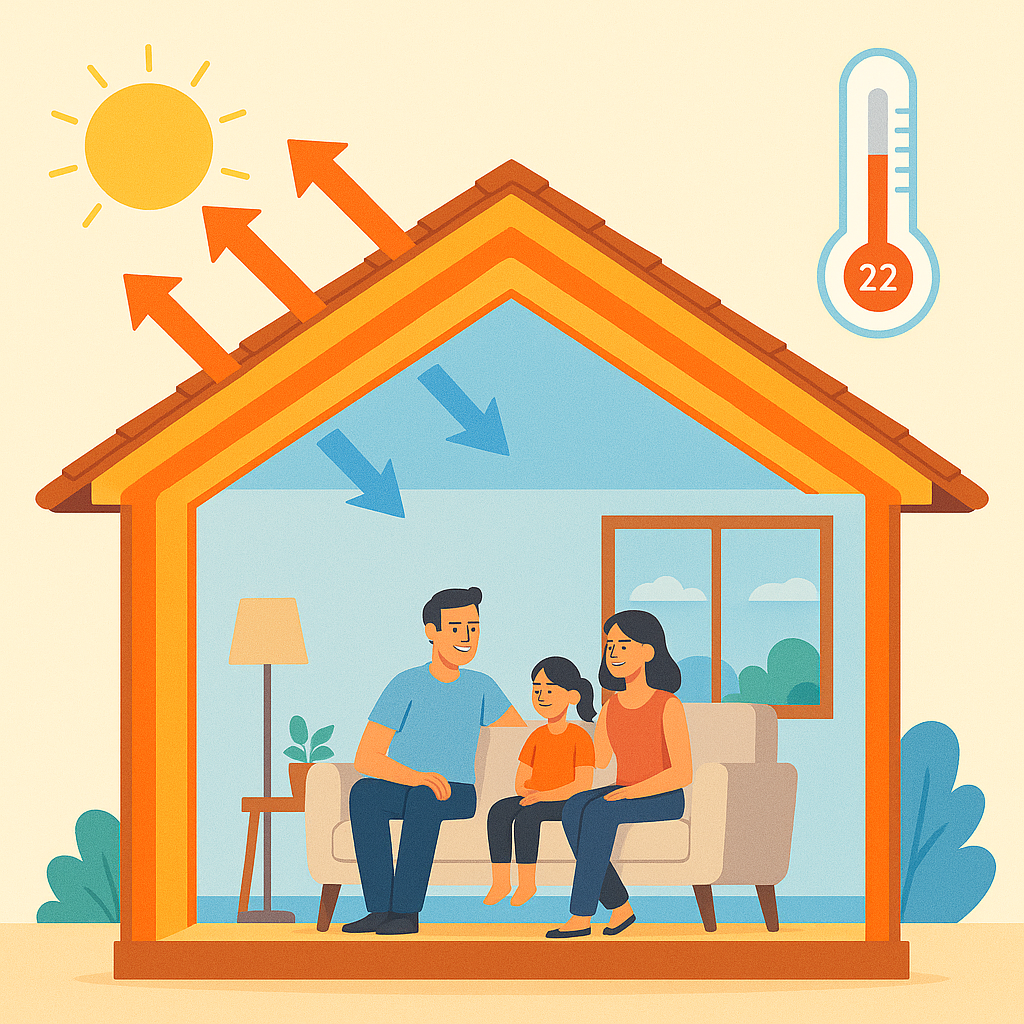Every home should be warm, comfortable and safe all year round. Unfortunately, this is not always the case. If your house is old, poorly built, located in a particularly cold area, or constant heating is too costly, it might get extremely chilly during the winter months.
Luckily, there are a number of things you can do to keep your house nice and toasty even on the coldest days. UK Energy Management (NE) Ltd have come up with a few handy tips to make sure you don’t go cold this winter.

Install insulation
Around 25% of an uninsulated building’s heat is lost through its roof, and as much as a third can be lost through its walls. Installing 25cm of insulation throughout your loft can reduce the amount of warm air being lost through your roof. This can be done fairly cheaply and easily, and loft insulation often also qualifies for subsidised or free installation under government schemes and grants like ECO3.
While cavity wall insulation is usually more expensive to install than loft insulation, it can save hundreds of pounds a year on energy bills. It is also covered by the ECO3 scheme in most cases, as well as some other grants and schemes – check with your energy supplier or the team here at UK Energy Management UK (NE) Ltd to see if you qualify.
There are many different types of insulation, each with its own advantages – a little research and some expert advice will help you find the right insulation solution for you and your home.
Bleed your radiators
Your radiators are most likely the first port of call when you get a little chilly during the winter months. The last thing you want is for them to let you down when you need them most, so it’s a good idea to ensure they’re in working order before the cold weather strikes. If they aren’t working effectively, it’ll take much longer to heat your home or they’ll fail to do so altogether.
You might realise that your radiators have cold patches, don’t heat up evenly, or make loud gurgling noises when you try to use them after a period of inactivity. This usually means they need bleeding, which is a quick and easy way to get them working at their best again. All you need to do is use a radiator key or flat-headed screwdriver to loosen the bleed valve, which you can find on the top left or top right of the radiator.
Fit thermal curtains
The sun is a great (and free) way to heat your home, so be sure to let sunlight in during daylight hours – even if it doesn’t appear to be particularly glorious outside. When the sunlight fades, close your curtains, as they act as another layer of insulation that acts to keep warm air in your home and cold air out. A set of heavy, lined curtains or thermal curtains will work best.
Be sure to check your windowpanes for any gaps which could let cold air into your home, and repair any you find – this will help with keeping your home warm and preventing condensation, which can cause damp and other problems.
Upgrade to a new boiler
One of the most important things to do ahead of winter is to ensure your boiler is in good working condition. If your boiler is more than 10 years old, it’s highly likely that it doesn’t work as efficiently as it used to. This can cause your energy bills to skyrocket, as your boiler has to work much harder to heat your home to the desired temperature.
It is recommended that you get your boiler serviced every twelve months, ideally before you need to start using it in the colder months. This will help you identify whether your current boiler is working efficiently and safely enough to see you through another winter, or whether you’d be better off upgrading to a newer, more efficient model. You’re far less likely to have to deal with costly and inconvenient boiler problems further down the line if you upgrade your boiler whenever necessary.
Install an electric heating system
While energy-efficient gas boilers are certainly an improvement, they can still be inefficient, difficult to programme to suit your needs and leave your property feeling cold at the most inconvenient times. An electric central heating system is far better suited to modern buildings and modern life.
Whether you choose to have an electricity-powered boiler or just smart electric radiators, this option allows you to have full control over each individual room that has an electric radiator in it. This reduces your energy waste by only heating localised parts of the house, rather than the whole building.
Electric heating systems also only use enough energy to achieve the right temperature and then lower their heat output in order to maintain the correct temperature. Overall, this means your heating system will be incredibly efficient and you’ll likely end up using less energy in order to stay nice and warm throughout the winter.
There are electric heating grants and schemes available that can subsidise or completely waive the cost of installation, or help out with energy bill payments.
Decorate with rugs
Exposed floorboards are an incredible feature and have grown in popularity in recent years due to their characterful aesthetic. That being said, they aren’t the best choice when it comes to retaining warmth within your home, especially if they’re old or have gaps between the slats.
Sealing your boards to eliminate these gaps is a great way to trap heat indoors but, if you don’t have the time or energy for that, you could always find some statement rugs to make any room that much cosier. They are practical but also decorative – you can find one to complement any home design, so you won’t lose that all-important aesthetic value.
Use a heating timer
While it’s tempting to keep your heating on a low setting at all times, this will have a huge impact on your energy bill. A better option is to use your boiler’s built-in timer settings so that you’re only heating your home for a few crucial hours of the day, rather than wasting it. Research shows that this can result in energy savings of 40% compared to a house with no timer or smart thermostat controls.
Whether you set it to come on half an hour before you wake up in the morning or an hour before you get home from work, having the heating on for slightly longer but at a lower temperature is the most efficient way to heat your home. This is because a boiler heats up at a constant speed whether you set your thermostat to 20℃ or 30℃, so putting it on full blast when you first get back from work won’t warm you up any quicker but will cause your energy bill to increase.
Get draught excluders
Even small draughts can make your home considerably colder and your heating far less efficient – even before you turn up the thermostat. It’s good practice to regularly check common places that cracks or gaps can appear – for instance, around windows, under windowsills, or underneath doors – before the cold weather sets in. If you do find some draughts, either sealing them up or using draught excluders to block the gaps is the best way to ensure warm air isn’t escaping and cold air isn’t entering.
Check your eligibility for a cavity wall insulation grant
Old homes, poor quality buildings, rising energy costs, and the current economic climate in the UK mean that many people cannot afford to sufficiently heat their homes. The Energy Company Obligation (ECO) scheme aims to tackle this problem by helping low-income, fuel poor, and/or vulnerable households cut their energy costs by providing free energy-efficient home improvements. The measures that can be installed under the ECO3 scheme include fully funded cavity wall insulation, loft insulation, heating systems, and new boilers.
Certain eligibility criteria must be met in order to qualify, one of which is being in receipt of specific benefits. If you think you require assistance but don’t receive benefits, don’t give up hope just yet – there is a Local Authority Flexible Eligibility scheme that allows for broader qualifying criteria, as do its in-fill mechanisms. Check your eligibility online today.
Keep Yourself and Your Home Warm This Winter with UK Energy Management (NE) Ltd
If you need help keeping your home nice and warm this winter, look no further than UK Energy Management (NE) Ltd. We are a national organisation dedicated to helping people access warm heat grants in the UK and secure the financial support they need. Our experienced technicians will be happy to install all the necessary upgrades to keep your home at the perfect temperature all year round. For more information on how we can help you, or to check your eligibility for a grant or scheme, visit our website or contact us today.



